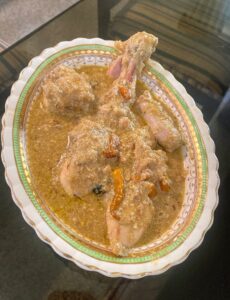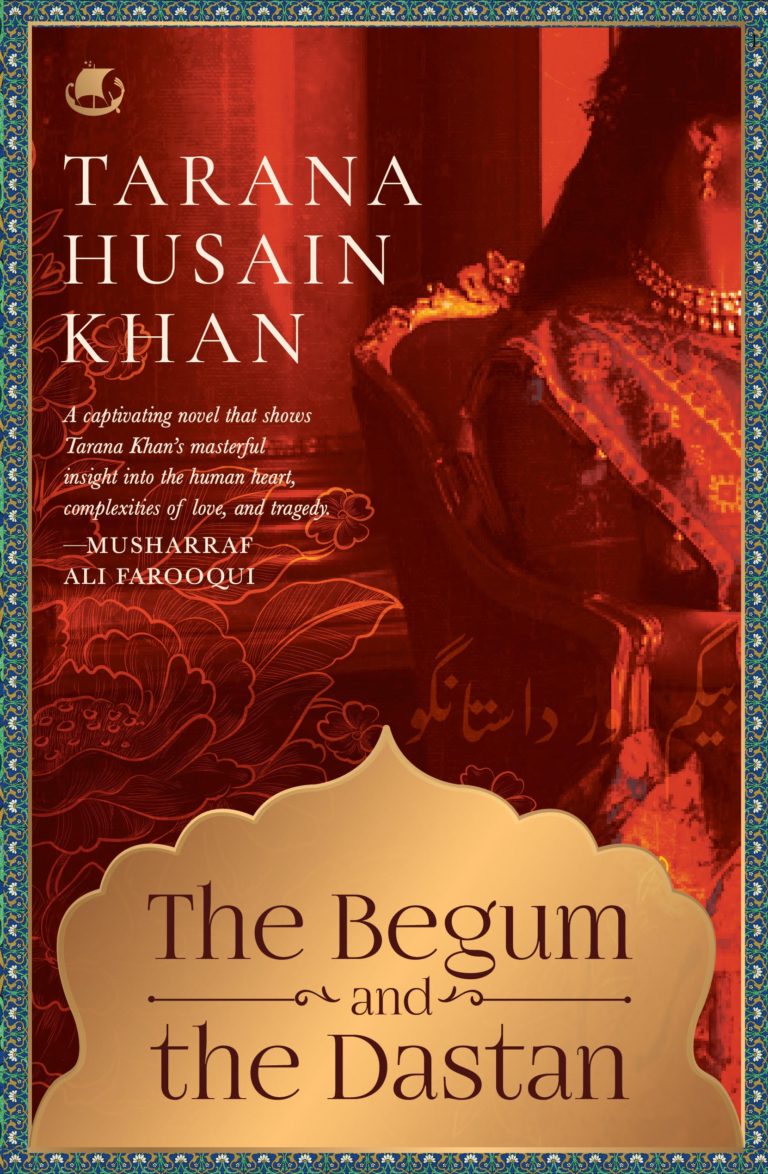The Rezala Route, From History to Plate
I adore Bengali cuisine. So the invitation to a Kolkata Book Club for a talk on my book, The Begum and the Dastan, was an almost karmic manifestation. I had wanted to visit the city to research my next book and I had a long list of dishes and iconic restaurants to explore. Chief among them was Sabir’s, to try their rezala, as recommended by a friend, Afreen Alvi.
Rezala…I rolled the unfamiliar word on my tongue. I had not heard of this dish in my North Indian-UP-Awadhi-Rampuri sphere of gastronomical experience. It sounded royal. The rezala at Sabir bowled me over. It was opulent and sublime with no sharp edges, with a yoghurt base, mild spices, a light hint of kewra. The flavours were reminiscent of the white qorma we cook in Rampur.
As I continued my food journey ticking off Kolkata culinary must-haves — Aminia’s biryani, Nizam’s kathi rolls, Mullick’s mishti doi, Royal’s chaap, shorshe illish — rezala continued to intrigue me. The word rezala means ‘a person of low birth, mean, vile’ and the meaning of the word was irreconcilable to the opulence of the dish. Did rezala have lowly origins and then traverse a culinary route up the social ladder? I needed to find out.
REZALA’S CULINARY PAST
Dhakai Khabar (The Cuisine of Dhaka), published by Dhaka: Bangladesh Asiatic Society in 2010, asserts that the term rezala comes from ‘rozil’ and ‘rozila,’ a dish cooked by them. Rozil is the Bengali pronunciation of razil, and rozila was the culinary outcome resulting from the conversion of the people of East Bengal to Islam under the influence of the Mughal rulers. (Muslim rulers dominated the political scene in Bengal from the 14th to the 18th century). The new converts adapted the cuisine of the Mughal or the Afghan ruling class. The women started the custom of soaking green chillies (cheap and easily available) in milk and then adding the chillies and milk to the korma. This became the rezala, which was traditionally eaten in Dhaka with murgh pulao, safed pulao, and baqarkhani roti.
The coming of Nawab Wajid Ali Shah to Bengal in 1856 stirred the proverbial culinary pot. The simple dish was probably given a leg up by the cooks and the gourmands at Metiaburj, who added an Islamic touch to Bengali cuisine, to delight the tastebuds of the Nawab in exile. Around the same time posto, the residue of opium production, found its way into Bengal cuisine and it might have been used in the new royal reincarnation of the poor man’s dish along with large amounts of ghee, dry fruits and spices. Oh! Calcutta Cookbook says the exiled Nawab Wajid Ali Shah and the descendants of Tipu Sultan brought their bawarchis (cooks) and mashaalchis (spice mixers) with them and their influences ‘came alive in dishes as subtle and rich as rezala.’ The iconic Aminia and Royal restaurants trace their establishment to these royal rakabdaars (cooks) of Metiaburj.
My Hindu Bengali friends don’t cook rezala — though some said their mothers cooked it — but it is a regular dish in Muslim households. The Calcutta Cookbook: A Treasury of Recipes from Pavement to Palace, by Minakshie Das Gupta, Bunny Gupta and Jaya Chaliha describes rezala as ‘a Bengali Muslim specialty.’ My aunt’s Bengali friend, Shahnaz khala’s family recipe has boiled meat cooked in ghee with whole garam masalas, onion paste, milk and green chillies.
East Bengal, ruled by the Nawabs of Dacca since 1875, developed a different version of Bengali cuisine.The Dhaka Nawab family shared a recipe with food writer Pritha Sen, which uses turmeric, yoghurt, ginger, garlic and green cardamom, ghee mixed with oil, and saffron — very similar to the shahi rezala of The Calcutta Cookbook. In Dhaka, it is called nichey dalan ka rezala and cooked by the people living in the lower courtyard, namely the servants.
Food writer, Priyadarshini Chatterjee, explained that rezala was supposed to be a light dish for a convalescent, where the meat is marinated in a large amount of yoghurt and spices and slow-cooked.

Aroona Reejhsinghani’s Delicious Bengali Dishes (1975) has a ‘mutton with curds’ recipe, which calls for turmeric and chilli powder to be added to the marinated meat — Jo Sharma, my friend and fellow researcher from Culinaria Research Center, University of Toronto says it is rezala. The use of turmeric in rezala is considered blasphemous by West Bengal gourmands. The same cookbook has two other recipes— one from Begum Unaiza Khan Chaudhary calls for the addition of dried sour plums, chopped pistachios, almonds and cashew nuts; while the shahi rezala adds turmeric, milk, cream and saffron to the gravy.
Oh Calcutta! Cookbook’s rezala recipe includes mawa, coconut paste, kewra and spices. As in Shahnaz khala’s recipe there is no marination, and the mutton is boiled with whole spices. Jayanta Sengupta, researcher and Secretary and Curator of Victoria Memorial Hall, says that the more popular version of yoghurt-based rezala appears in Renuka Devi Chaudhurani and Rakamari Amish Ranna’s A Variety of Non-Vegetarian Dishes compiled in the 1930s and 1940s. Two versions are mentioned, both have a yoghurt base and are slow-cooked in the dum method; the second version recommends adding diced apples and pineapples, and also vegetables like potato, turnip, cabbage or peas.
Pritha Sen believes that the use of whole spices and chopped dry fruits like dried plums, almonds and cashews points to rezala being a dish with Afghan origins. “Since there is no rezala in Afghan cuisine, it was possibly created by dropping off expensive ingredients and adding green chillies to Afghan curry.”
Incidentally, rezala is also a favourite dish of the Bhopalis — the only other place outside West Bengal and Bangladesh where it is popular — who have added large amounts of coriander to the basic Bengali rezala.
The trajectory of a dish has unexpected entanglements of historical events and culinary influences. Today, the posh version of rezala is served at restaurants across Kolkata, but, its sojourn in humble kitchens is largely forgotten.
RECIPE FOR REZALA
(Courtesy Afreen Alvi)
Ingredients
1 kg chicken (or 500 gm mutton)
200 ml vegetable oil
1 cup boiled onion paste
2 tsp ginger paste
2 tsp garlic paste
1/2 cup yoghurt whipped
2-3 whole red chillies
1 tsp garam masala powder
2 tsp poppy seeds, soaked for an hour and finely ground
4-5 green cardamom
4-5 cloves
2-3 bay leaves
1 inch cinnamon stick
Salt to taste
Method
Heat the oil in a pan. Reduce to medium heat. Add cardamoms, cloves, peppercorns and chillies.
Add onion paste and sauté till oil separates. Add ginger and garlic pastes and continue to sauté.
Add the chicken or mutton pieces and continue to fry for about 3 to 4 minutes on low heat. Add bay leaves, and yoghurt. The yoghurt should be smooth. Mix and cook for about a minute.
Add water (depending on the meat) and cook the meat till it becomes tender. You might have to cook the mutton in a pressure cooker.
If the curry is very watery keep boiling till it thickens. Add the poppy seed paste. Cook on medium heat till oil comes on top and the curry has a thick consistency.
Serve hot with roomali roti or parathas.
Tarana Husain Khan is a writer and food historian. She is currently working on an Arts and Humanities Research Council-funded project to revive heirloom recipes and rice varieties.



